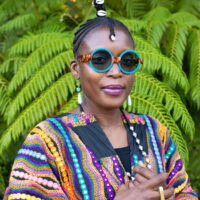Exhibition Info
Adama Delphine Fawundu’s art is centered on personal and cultural memory, as well as narratives connecting Africa and its diaspora. Textiles and repeated patterning accompany her photography to become an interplay of fact and fiction, history and memory. Fawundu’s banner and pole installation, Joyful Blues, combines photographs taken in the late 1990s of Black girls in Brooklyn as well a garra fabric designs from Sierra Leone, West Africa. Together, they offer a symbolic backdrop for a reading of the park, one that merges into the landscape like a piece of clothing on the body, deeply informed and shaped by the people that wear them. A representation of ancestral knowledge, the work is meant to inform future generations to embody freedom, love, and joy.
The banners feature photographs from the series I Am Here: Girls Reclaiming Safe Spaces of Black girl culture mostly in Brooklyn, but also in South Africa and Ghana, from 1997 to the early 2000s. This series promotes the idea of safe spaces and freedom for Black girls both within and outside of their bodies. The textiles adorning the banners and poles are from the artist’s For Mama Adama series, inspired by Fawundu’s Grandmother’s garra textile business in Sierra Leone, West Africa. The process of making this photographic series, which includes making film from her grandmother’s fabrics and layering them into new prints, is symbolic of the power within intergenerational stories and ancestral knowledge.
Fawundu uses garra, a form of tie-dying and batiking. The artist notes about this process, “drawing on the layered nature of Garra fabrics, I combine these processes to create new patterns and new languages while activating body memory and my ancestral consciousness.” Textile patterning in Fawundu’s artwork provides a platform for broader questions about history: what layers are covered and what is revealed? Where do the patterns of history start and where do they lead? The circle motifs evoke the continuum of the past, present, and future that our bodies hold. Garra is a time-consuming hand-dying technique usually made in a communal multi-step process. Understanding this lineage allows for a richer understanding of how history can be rewritten. A complex patterning that when pieced together into one whole a richer fabric is created.
“…drawing on the layered nature of Garra fabrics, I combine these processes to create new patterns and new languages while activating body memory and my ancestral consciousness.”
Fawundu has over twenty years of experience working as a photographer in Brooklyn. She gained her reputation documenting global Hip-Hop and urban youth culture since the 1990s and has grown her practice to include printmaking, video, sound, and assemblage. Her work has been included in such seminal exhibitions and books as Contact High: A Visual History of Hip-Hop, Fashioning Black Masculinity: The Origins of the Dandy Lion Project, and Reflections in Black: A History of Black Photographers 1840 to the Present.
Fawundu co-founded MFON and independently published the book MFON: Women Photographers of the African Diaspora. Her work is included in private and public collections including those of the Brooklyn Museum and The Center for Brooklyn History, both in Brooklyn, NY; Norton Museum of Art, West Palm Beach, FL; Corridor Contemporary, Philadelphia, PA; David C. Driskell Center, University of Maryland; and the Museum of Contemporary Art, University of São Paulo, Brazil. She has presented her work at the Schomburg Center for Research in Black Culture, Harlem, NY; and Harvard University, Cambridge, MA; Tate Modern, London, England. Fawundu has received awards from the Rema Hort Mann Foundation, and OkayAfrica’s 100 Women. Her fellowships and residencies include BRIClab Contemporary Art, Brooklyn, NY; Center for Book Arts, New York, NY; and Project for Empty Space, Newark, NJ. Fawundu received an MFA from Columbia University.
Bios
Related Content
The Lena Horne Bandshell at Prospect Park is home to BRIC Celebrate Brooklyn!, New York’s longest-running, free outdoor performing arts festival. Named to honor the legendary singer, actress, dancer, and Brooklyn native Lena Horne, the Bandshell is transformed into a venue every summer that can accommodate over 8,000 people.
Accessibility
The facility is completely wheelchair accessible. Accessible entrances, exit points, seating, and concessions are available for every event. When you arrive at the Bandshell, you are welcome to ask any of our entrance staff for assistance. Our Community Care Manager and team will escort you and one guest to an accessible seat. Please note that our ADA seating section is first-come first-serve and some views of our stage may be partially obstructed. If you have any other questions about accessibility, please contact [email protected].







